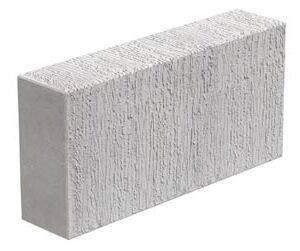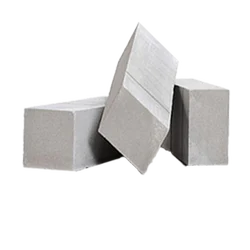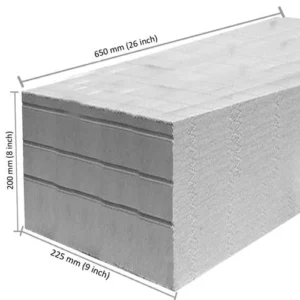Category: AAC Blocks
We Provide Best Autoclaved Aerated concrete check AAC blocks Size 9 inch, 8inch, 6inch, 5inch, Weight, Density, Advantages Price ₹ 40- ₹ 110 Manufacturers in Hyderabad you can order aac blocks online
Showing all 4 results
-

4 Inch AAC block 600mm x 200mm x 100mm
₹110.00 -

6 Inch AAC block 600mm x 200mm x 150mm
₹110.00 -

8 Inch AAC block Price 600mm x 200mm x 250mm
₹110.00 -

9 Inch AAC block 600mm x 200mm x 250mm
₹110.00
A Comprehensive Guide to AAC Blocks: Unveiling Their Unique Advantages
Introduction:
Welcome to our in-depth guide on AAC (Autoclaved Aerated Concrete) Blocks, focusing on the exceptional advantages offered by these innovative construction materials. In this guide, we’ll explore the diverse benefits that make AAC Blocks a preferred choice for modern construction projects.
History of AAC Blocks
Early 20th Century
AAC technology originated in Sweden in the 1920s when Johan Axel Eriksson developed a process to create a light building material with thermal insulation properties. This marked the beginning of AAC as we know it today.
1929
The first AAC plant was established in Sweden.
1943
AAC technology was introduced to the United Kingdom.
1960s-1970s
The use of AAC spread to other European countries and later to Asia.
1980s-1990s
AAC gained popularity in the construction industry as a sustainable and energy-efficient building material. Its use expanded globally.
2000s-Present
AAC continues to be widely used in various construction projects around the world. The technology has evolved, and AAC has become a standard material in many countries for its unique combination of properties.
Key Components of AAC Blocks
Fly Ash or Silica Sand
Depending on the availability of raw materials, either fly ash (a byproduct of coal combustion) or silica sand is used as the primary source of silicon dioxide.
Cement
Ordinary Portland cement is typically used as a binding agent in AAC blocks.
Lime
Quicklime (calcium oxide) is used to provide additional strength and improve the workability of the mixture.
Aluminum Powder
Finely ground aluminum powder is a key component that reacts with lime and water to generate hydrogen gas, creating air bubbles within the concrete mixture. This contributes to the lightweight nature of AAC.
Water
Water is used to facilitate the chemical reactions and to form a slurry that can be easily poured into molds.
Setting Agents
Setting agents, such as gypsum, may be added to control the setting time of the concrete mixture.
Manufacturing Process
The manufacturing process involves mixing these components, pouring the mixture into molds, and subjecting it to high-pressure steam curing (autoclaving). The steam-curing process results in the formation of a crystalline structure within the blocks, enhancing their strength and other desirable properties.
Benefits of AAC Blocks:
Affordable yet Effective:
Cost Savings: Reduces operating cost by 30-40% and overall construction cost by 2.5%, requiring less jointing and reducing the need for cement and steel.
Energy Efficiency: High-insulation blocks save up to 30% in energy costs.
Space Optimization: A wide variety of block sizes increase the carpet area.
Long-lasting Finish: Plastering and wall painting last longer as almost nil efflorescence affects AAC blocks, lowering maintenance costs.
Helps You Build Quickly:
Time Efficiency: Drastically reduces construction time by 20% due to multiple block sizes, minimizing the number of joints in a wall.
Ease of Construction: Lighter blocks make construction easier and quicker.
Quick Installation: Lightweight blocks are easy to install, set, and harden quickly.
Resistant to Natural Disasters:
Fire Resistance: AAC blocks are non-combustible and can withstand temperatures up to 1600 Celsius.
Thermal Insulation: The thermal mass and tiny air pores provide excellent thermal insulation, reducing heating and air conditioning costs.
Earthquake Resistance: Offers required strength, acting as earthquake-resistant structures.
AAC Block Sizes Guide
| Size (mm) | Size (inches) |
|---|---|
| 600mm x 200mm x 50mm | 1.97 inches |
| 600mm x 200mm x 75mm | 2.95 inches |
| 600mm x 200mm x 100mm | 3.94 inches |
| 600mm x 200mm x 150mm | 5.91 inches |
| 600mm x 200mm x 200mm | 7.87 inches |
| 600mm x 200mm x 230mm | 9.06 inches |
| 600mm x 200mm x 250mm | 9.84 inches |
| 600mm x 200mm x 300mm | 11.81 inches |
Traditional AAC Blocks Arrangement:
AAC blocks, similar to conventional masonry units, are arranged in stacks. The stacking process involves placing the blocks horizontally on top of each other, following established patterns. The key difference lies in the application of a thin-layered mortar during the arrangement process. This mortar enhances the bond between blocks, ensuring structural integrity.
For structural purposes, AAC walls may incorporate grouted, reinforced cells, and beams within the wall sections. This reinforces the overall strength of the structure, adding durability and stability.
The manual arrangement of AAC blocks is a common practice, particularly for smaller projects where the size and weight of individual blocks are manageable. However, for larger and heavier AAC panels, mechanical assistance such as cranes is often necessary due to their substantial size and weight.
AAC Blocks Shapes
Lintel Blocks:
Lintel blocks, also known as U-shaped bond beams, play a crucial role in architectural and structural design. These blocks are available in various thicknesses, including 8, 10, and 12 inches. Lintel blocks are strategically placed to provide horizontal support, distributing the load efficiently across the structure.
Tongue-and-Groove AAC Blocks or Slabs:
Tongue-and-groove AAC blocks or slabs are designed for seamless interlocking without the need for mortar at the vertical edges. This innovative design enhances the structural integrity of the wall by creating a strong and cohesive connection between adjacent units. The availability of large sizes further contributes to faster construction and increased efficiency.
Cored Blocks:
Cored blocks find application in constructing vertical reinforced grout cells. These blocks are designed with cavities or cores, allowing for the insertion of reinforcement materials and the pouring of grout. The resulting combination of cored blocks and grout creates a robust and reinforced structure, ideal for areas where additional strength is required.
How to Use AAC Blocks
Installing AAC (Autoclaved Aerated Concrete) blocks is quite similar to regular concrete blocks. For larger panels, you’ll need a crane for support. Depending on the finish you want, these panels can be stuck on or attached mechanically to the AAC surface.
Finishing Touches for AAC Blocks
AAC blocks have different finishes:
1. Stucco-Type Finishes:
These are like protective layers that keep water out but allow the material to breathe.
2. Masonry Veneers:
You can stick these directly to the wall or build them as a double layer with a gap in between. They’re usually pretty light.
3. Conventional Siding Materials:
If you’re using regular siding materials, you’ll attach them to the wall. Sometimes, you might need extra strips for ventilation.
Where You’ll Find AAC Blocks
AAC blocks are used all over! In houses, offices, factories, and more. Because they’re good at keeping things warm or cool, they’re perfect for big buildings.
Check this out too: Everything you need to know about eco-friendly homes
AAC Blocks vs Red Bricks
AAC blocks are better for a few reasons:
- They’re way lighter, so you use less cement and steel, saving money.
- They’re better for the environment, last longer, and keep things quiet and comfy inside.
Check this out too: All about GST on bricks and other building materials
AAC Blocks vs CLC Blocks: Which is Better?
When it comes to strength:
- AAC blocks are stronger than CLC blocks.
Top AAC Block Manufacturers
| Brand Name | Company Name | Available Thickness | Location | Year of Establishment | Website URL |
|---|---|---|---|---|---|
| Finecrete AAC Block | Finecrete Eco-Blocks Pvt Ltd | 75–200 mm | Gurgaon, Haryana | 2013 | Visit Website |
| JK Lakshmi AAC Block | JK Lakshmi | Not specified | Not specified | Over 50 years | Visit Website |
| Biltech AAC Block | Avantha Group (Biltech) | Not specified | Multiple plants across India | Not specified | Visit Website |
| Magicrete AAC Block | Magicrete Building Solutions Pvt Ltd | 100–225 mm | Surat, Gujarat | 2008 | Visit Website |
| Renacon AAC Block | Renaatus Procon Pvt Ltd | Not specified | Coimbatore, Tamilnadu | 2012 | Visit Website |
| Ambuja Cements AAC | Ambuja Cements Ltd | 100–225 mm | Mumbai | 2014 | Visit Website |
| Godrej AAC Block | Godrej & Boyce Mfg. Co. Ltd | 100–225 mm | Mumbai, Maharashtra | 1897 | Visit Website |
| Renaatus AAC Block | Renaatus Procon Pvt Ltd | Not specified | Coimbatore, Tamilnadu | 2012 | Visit Website |
| Aceton AAC Block | Aceton Industries LLP | 100–225 mm | Mumbai, Maharashtra | 2005 | Visit Website |
| Birla Aerocon AAC Block | Birla Aerocon | 100–225 mm | Hyderabad, Telangana | 1946 | Visit Website |




